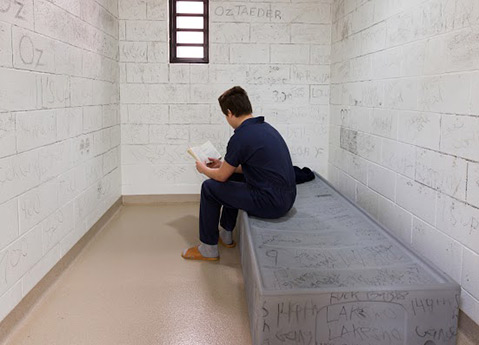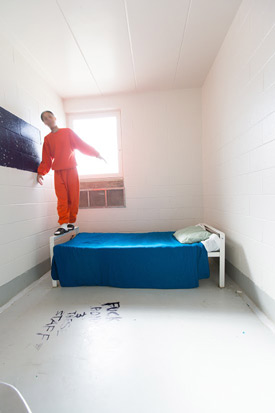‘Isolated’ by Richard Ross at SBCC
SB Artist Documents Juvenile Justice System

“It’s really my magnum opus,” says Richard Ross of the Juvenile in Justice project he has pursued nonstop for the past eight years. “It’s been the most punishing thing I’ve ever done, and the most rewarding.”
Ross has just installed Isolated, his new exhibition on the solitary confinement of juvenile offenders. The show consists of another set of Ross’s astonishing prison photographs, but at its center there’s something else, something three-dimensional and immersive: a scale model of an isolation cell. Inside it, and above the standard featureless cot that is the tiny room’s only furnishing, a loudspeaker wired to the ceiling pours forth a soundtrack of young men and women baring their souls in the process of explaining and justifying their wrecked lives.
The photos Ross takes are ordinarily designed to protect the privacy of his subjects, but his new installation was designed with an eye to invading the privacy of someone else — the viewer. “I like it that it’s distracting,” Ross says to me as the sound of taped testimony interrupts our conversation. “It should be distracting because that’s what life is like for these kids.”

Ross was once lauded for the elegance and rigor of his images of museums, and the transformation that brought him to his current obsession with the justice system occurred in stages. After a project documenting nuclear fallout shelters came out in 2004, Ross followed it with Architecture of Authority in 2007, which featured images of everything from the holding cells at Guantanamo Bay to the office of the assistant principal for discipline and attendance at Santa Barbara High School. Clearly something clicked for Ross around this time because ever since, he has been working like a man possessed, and the results he has achieved are truly extraordinary. It’s safe to say that in Ross, Santa Barbara can lay claim to being the home of one of the world’s most important — and fearless — documentary photographers.
Every image is the result of an arduous process of negotiation, one that begins with the various officials who must approve his entry into the prisons he visits, and that only ends when he establishes a connection of trust with his subjects. That last step is clearly a doozy, and one that very few people attempt. Ross outlined the way he does his interviews like this: “When I get to the cell, the first thing I ask for is permission to enter. No one else who comes to them asks the kids for that, so right away I’m signaling that this is going to be different. When I get inside, I take off my shoes. They usually don’t have shoes on, so neither should I. Then I sit on the floor; that’s where I go before I ask any questions.”
This routine, which Ross has developed by trial and error over the last eight years, is what makes his life-changing work possible. It’s also what makes this unforgettable show so worthwhile. I recommend it to everyone who visits the Atkinson between now and December 4. Look at the images and then enter the cell. Take off your shoes. Sit on the floor. Listen to the voices. As Ross says, “These are our kids.”



